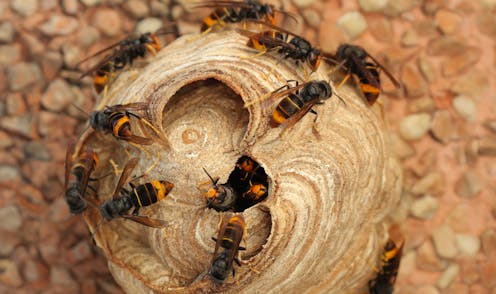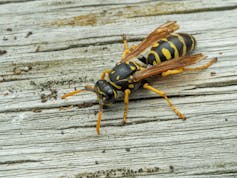
The sight of a swarm of wasps, or even just a single wasp, strikes fear into many people’s hearts. Most wasp species aren’t dangerous to humans (unless you’re allergic), but their stings are painful.
Some wasp species can wreak havoc in other ways, though. Take the family Vespidae, which includes more than 5,000 species. Of those, about 700 are social wasps, meaning they live in groups, with nests containing anywhere between 25 and 7,000 wasps.
Sometimes social wasps are able to reach countries beyond their natural range and establish populations there. This usually happens when hibernating queens accidentally travel as stowaways, having chosen a safe spot (like a golf bag) to hide in through the winter.
It doesn’t take much to start a colony in a new place: a male drone mating with a single queen can produce a founding colony that can sire more than 9,000 offspring over a season and hundreds of new queens that can build their own nests the following season.
This can have dire ecological and socio-economic impacts.
In Argentina, for example, wasps that arrived from Europe in the 1970s cause millions of US dollars in damage every year. These wasps complicate agricultural activities, damage fruit in certain situations, and cause declines in honey bees and other beneficial insects and the ecosystem services they provide.
I am an ecological entomologist in South Africa who studies the effects of biological invasions. With my colleagues at the South African National Biodiversity Institute and Stellenbosch University, I’m working to monitor the country’s existing invasive social wasp populations and prevent them spreading. This is no simple task because there are not enough invasion biologists and funds to monitor all the threats.
That’s why we’re now turning to citizen scientists for help. With the help of the general public we believe we can keep the potential threat of spreading wasp populations under control.
Current invaders
There are two invasive social wasp species in South Africa. The German wasp (Vespula germanica) is both a generalist predator of insects (mostly flies) and a scavenger. If yellow wasps with black antennae descend on your picnic, trying to steal meat off your plate, you’re dealing with a German wasp. They mostly form nests underground but can nest in vents and holes in buildings.
The European paper wasp (Polistes dominula) always nests above ground. There are far fewer workers per nest and you can tell them apart from Vespula germanica by their orange antennae and the fact that they fly with their legs hanging. Vespula germanica tuck their legs in during flight.
Read more: How biological control agents could get invasive stinging wasps to buzz off
Both species are limited to a small but populated part of the Western Cape province, mainly the greater Cape Town area. Worryingly, the German wasp was recorded in the Cederberg (about 240km from Cape Town) for the first time in 2024. This means the species is on the move after quite a slow start in South Africa.

The German wasp population was first established in Cape Town’s Kirstenbosch botanical gardens in 1972, followed by a second wave of invasion in 2001. The European paper wasp was first detected in Kuilsrivier in 2008. It has since established populations in Porterville to the north of Cape Town and Hermanus to the east. Both species are thought to have been accidentally transported by either ship or plane.
It is prohibitively expensive to eradicate these species because they’ve become so entrenched in these ecosystems. The good news is that they haven’t jumped to another province – yet. But we’re not sure how long that will remain the case.
Honey bees at risk
Today, people are directly and indirectly making habitats better for social wasp invasions. We do this by providing them, unknowingly, with transport to new destinations. In our connected world there are countless opportunities for invasions to occur.
Read more: Invasive alien species are a serious threat to the planet: 4 key messages for Africa
South African researchers are especially worried about the Asian hornet (Vespa velutina). It arrived in France, most likely in a shipment of goods imported from east Asia, in 2004 and has since spread to large parts of western Europe, forming a multitude of nests in densely populated areas. The species hunts honey bees and has caused major damage to apiaries.
Read more: Asian hornets make UK their latest target – here’s why they’re such a threat to European bees
South Africa is home to anywhere between 1 million (conservative estimates) and 10 million wild honey bee colonies, in addition to a formal and vibrant beekeeping industry. An invasion by the Asian hornet would be disastrous because it is a specialist predator of honey bees. (The German wasp also sometimes targets honey bee hives.)
The Asian hornet is a big wasp. Workers and queens range from 2.5cm to 3.5cm, resulting in higher volumes of venom being injected during a painful sting. They build their nests in trees, making them dangerous and cumbersome to destroy: if nests are not carefully destroyed the wasps go into a frenzy and attack any perceived threat in their vicinity.
So, how can the public help?
Citizen science
If you live in the Western Cape (or anywhere in South Africa) and have a smartphone with a GPS and a camera, you’re all set. By photographing any wasps you see and uploading them to citizen science platforms like iNaturalist, you can help scientists track species. Evidence has shown how valuable such platforms are for biodiversity research.
A good picture of a social wasp should be from the top, on normal camera setting about half a metre to a metre from the insect (or a bit further if photographing a wasp nest). Move slowly. Wasps collecting food aren’t usually a stinging risk because they are too focused on getting a meal back to the nest as quickly as possible. Even pictures of dead wasps on your windowsill or in a light cover can be useful if you post them. Don’t forget to add the date and a GPS pin.
Pictures can allow experts to confirm the identity of the species, which can then be used to research the distributions and new geographic records of potentially invasive species.
Ruan Veldtman is funded by the Department of Forestry Fisheries and the Environment.
This article was originally published on The Conversation. Read the original article.







